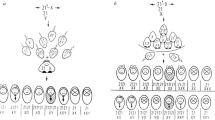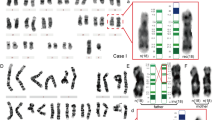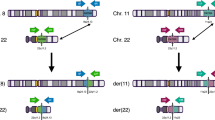Abstract
The constitutional t(11;22)(q23;q11) is a well-known recurrent non-Robertsonian translocation in humans. Although translocations generally occur in a random fashion, the break points of t(11;22)s are concentrated within several hundred base pairs on 11q23 and 22q11. These regions are characterized by palindromic AT-rich repeats (PATRRs), which appear to be responsible for the genomic instability. Translocation-specific PCR detects de novo t(11;22)s in sperm from healthy males at a frequency of 1/104–105, but never in lymphoblasts, fibroblasts or other human somatic cell lines. This suggests that the generation of t(11;22) rearrangement is linked to gametogenesis, although female germ cells have not been tested. Here, we have studied eight cases of de novo t(11;22) to determine the parental origin of the translocation using the polymorphisms on the relevant PATRRs. All of the eight translocations were found to be of paternal origin. This result implicates a possible novel mechanism of sperm-specific generation of palindrome-mediated chromosomal translocations.
Similar content being viewed by others
Log in or create a free account to read this content
Gain free access to this article, as well as selected content from this journal and more on nature.com
or
References
Fraccaro M, Lindsten J, Ford CE et al: The 11q;22q translocation: a European collaborative analysis of 43 cases. Hum Genet 1980; 56: 21–51.
Zackai EH, Emanuel BS : Site-specific reciprocal translocation, t(11;22) (q23;q11), in several unrelated families with 3:1 meiotic disjunction. Am J Med Genet 1980; 7: 507–521.
Kurahashi H, Shaikh TH, Hu P et al: Regions of genomic instability on 22q11 and 11q23 as the etiology for the recurrent constitutional t(11;22). Hum Mol Genet 2000; 9: 1665–1670.
Kurahashi H, Emanuel BS : Long AT-rich palindromes and the constitutional t(11;22) breakpoint. Hum Mol Genet 2001; 10: 2605–2617.
Edelmann L, Spiteri E, Koren K et al: AT-rich palindromes mediate the constitutional t(11;22) translocation. Am J Hum Genet 2001; 68: 1–13.
Tapia-Paez I, Kost-Alimova M, Hu P et al: The position of t(11;22)(q23;q11) constitutional translocation breakpoint is conserved among its carriers. Hum Genet 2001; 109: 167–177.
Kurahashi H, Inagaki H, Hosoba E et al: Molecular cloning of a translocation breakpoint hotspot in 22q11. Genome Res 2007; 17: 461–469.
Nimmakayalu MA, Gotter AL, Shaikh TH et al: A novel sequence-based approach to localize translocation breakpoints identifies the molecular basis of a t(4;22). Hum Mol Genet 2003; 12: 2817–2825.
Kurahashi H, Shaikh T, Takata M et al: The constitutional t(17;22): another translocation mediated by palindromic AT-rich repeats. Am J Hum Genet 2003; 72: 733–738.
Gotter AL, Shaikh TH, Budarf ML et al: A palindrome-mediated mechanism distinguishes translocations involving LCR-B of chromosome 22q11.2. Hum Mol Genet 2004; 13: 103–115.
Gotter AL, Nimmakayalu MA, Jalali GR et al: A palindrome-driven complex rearrangement of 22q11.2 and 8q24.1 elucidated using novel technologies. Genome Res 2007; 17: 470–481.
Kuroda-Kawaguchi T, Skaletsky H, Brown L et al: The AZFc region of the Y chromosome features massive palindromes and uniform recurrent deletions in infertile men. Nat Genet 2001; 29: 279–286.
Tanaka H, Bergstrom D, Yao M et al: Widespread and nonrandom distribution of DNA palindromes in cancer cells provides a structural platform for subsequent gene amplification. Nat Genet 2005; 37: 320–327.
Kurahashi H, Inagaki H, Yamada K et al: Cruciform DNA structure underlies the etiology for palindrome-mediated human chromosomal translocations. J Biol Chem 2004; 279: 35377–35383.
Kogo H, Inagaki H, Ohye T et al: Cruciform extrusion propensity of human translocation-mediating palindromic AT-rich repeats. Nucleic Acids Res 2007; 35: 1198–1208.
Kurahashi H, Shaikh TH, Zackai EH et al: Tightly clustered 11q23 and 22q11 breakpoints permit PCR-based detection of the recurrent constitutional t(11;22). Am J Hum Genet 2000; 67: 763–768.
Kurahashi H, Emanuel BS : Unexpectedly high rate of de novo constitutional t(11;22) translocations in sperm from normal males. Nat Genet 2001; 29: 139–140.
Kato T, Inagaki H, Yamada K et al: Genetic variation affects de novo translocation frequency. Science 2006; 311: 971.
Buwe A, Guttenbach M, Schmid M : Effect of paternal age on the frequency of cytogenetic abnormalities in human spermatozoa. Cytogenet Genome Res 2005; 111: 213–228.
Martin RH : Meiotic errors in human oogenesis and spermatogenesis. Reprod Biomed Online 2008; 16: 523–531.
Page SL, Shaffer LG : Nonhomologous Robertsonian translocations form predominantly during female meiosis. Nat Genet 1997; 15: 231–232.
Crow JF : The origins, patterns and implications of human spontaneous mutation. Nat Rev Genet 2000; 1: 40–47.
Leach DR : Long DNA palindromes, cruciform structures, genetic instability and secondary structure repair. Bioessays 1994; 16: 893–900.
Thomas NS, Morris JK, Baptista J et al: De novo apparently balanced translocations in man are predominantly paternal in origin and associated with a significant increase in paternal age. J Med Genet 2009.
Kato T, Yamada K, Inagaki H et al: Age has no effect on de novo constitutional t(11;22) translocation frequency in sperm. Fertil Steril 2007; 88: 1446–1448.
Inagaki H, Ohye T, Kogo H et al: Chromosomal instability mediated by non-B DNA: cruciform conformation and not DNA sequence is responsible for recurrent translocation in humans. Genome Res 2009; 19: 191–198.
Sinden RR : Cruciform structures in DNA: DNA structure and function. San Diego 1994; pp: 134–177.
Macville MV, Loneus WH, Marcus-Soekarman D et al: XX male with sex reversal and a de novo 11;22 translocation. Am J Med Genet A 2006; 140: 1973–1977.
Acknowledgements
This work was supported by grant-in-aids for Scientific Research, from the Ministry of Health, Labour and Welfare and the Ministry of Education, Culture, Sports, Science and Technology of Japan (19590322 and 21590346 to TO, 21390101 to HK), and CA39926 from the National Institutes of Health, USA as well as funds from the Charles EH Upham chair of Pediatrics (BSE).
Author information
Authors and Affiliations
Corresponding author
Ethics declarations
Competing interests
The authors declare no conflict of interest.
Additional information
Web Resources
The URLs for data presented herein are as follows:
Online Mendelian Inheritance in Man (OMIM), http://www.ncbi.nlm.nih.gov/Omim
Supplementary Information accompanies the paper on European Journal of Human Genetics website
Supplementary information
Rights and permissions
About this article
Cite this article
Ohye, T., Inagaki, H., Kogo, H. et al. Paternal origin of the de novo constitutional t(11;22)(q23;q11). Eur J Hum Genet 18, 783–787 (2010). https://doi.org/10.1038/ejhg.2010.20
Received:
Revised:
Accepted:
Published:
Issue date:
DOI: https://doi.org/10.1038/ejhg.2010.20
Keywords
This article is cited by
-
Constitutional t(8;22)(q24;q11.2) that mimics the variant Burkitt-type translocation in Philadelphia chromosome-positive chronic myeloid leukemia
International Journal of Hematology (2017)
-
Breakpoint analysis of the recurrent constitutional t(8;22)(q24.13;q11.21) translocation
Molecular Cytogenetics (2014)
-
DNA secondary structure is influenced by genetic variation and alters susceptibility to de novo translocation
Molecular Cytogenetics (2011)
-
Advanced age increases chromosome structural abnormalities in human spermatozoa
European Journal of Human Genetics (2011)



